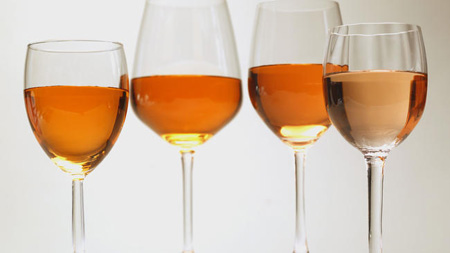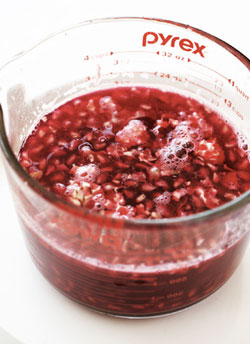 Which foods pair best with rosés? The question is almost beside the point. Rosés are made for warm summer evenings, dinners outdoors with friends and laughter. Serve dishes that fit with that kind of setting and you're on the right road.
Which foods pair best with rosés? The question is almost beside the point. Rosés are made for warm summer evenings, dinners outdoors with friends and laughter. Serve dishes that fit with that kind of setting and you're on the right road.
Think of summer foods, like tomato salads, olives, salumi, vegetables right off the grill. Rosés love brash flavors: salty, a little spicy, redolent of summer herbs like basil and oregano, and, of course, garlic.
Olives, cured with cumin and garlic or baked with herbs? Of course. Prosciutto and melon? Perfect. Toasts with tapenade? Even better.
Pork sausages right off the grill are terrific with rosés, and so are grilled vegetables, such as peppers, zucchini and eggplant, seasoned with handfuls of basil and moistened with good olive oil.
To my mind, there is no single better match for a dry rosé than a good aioli. Mash garlic and a little salt in a mortar and pestle. Beat in a couple of egg yolks, stirring until they're lemon-colored. Very slowly, a drop at a time at the start, stir in olive oil and maybe a little lemon juice, depending on your preference (I think it helps match the wine better). It should be the consistency of soft mayonnaise.


 If you spent three days driving throughout the Central Coast
wineries, from Santa Barbara to Los Pasos, you could not have sampled a
fraction of the wines you could have in an hour at Wally’s 8th Annual
Central Coast Food and Wine celebration. The event benefits the
Michael Bonaccorsi UC Davis Scholarship Fund and the endowment at Allan
Hancock College for students who want to pursue careers in Viticulture
and Enology. There were over 55 wineries serving 150 unique wines you
could sniff, swirl, taste and savor. It was like wandering from room to
room in one of your favorite art museums only to discover another
gallery filled with astonishing paintings you’ve never seen before.
If you spent three days driving throughout the Central Coast
wineries, from Santa Barbara to Los Pasos, you could not have sampled a
fraction of the wines you could have in an hour at Wally’s 8th Annual
Central Coast Food and Wine celebration. The event benefits the
Michael Bonaccorsi UC Davis Scholarship Fund and the endowment at Allan
Hancock College for students who want to pursue careers in Viticulture
and Enology. There were over 55 wineries serving 150 unique wines you
could sniff, swirl, taste and savor. It was like wandering from room to
room in one of your favorite art museums only to discover another
gallery filled with astonishing paintings you’ve never seen before.
 The more wines you try, the more you'll develop your palate-it's that simple. And how you try them makes all the difference. I know when you see wine tasters doing a lot of curious slurping it seems like a highly mysterious activity...but it's not. Swirl, sniff and spit, that's all it is. So why do we swirl? What are we looking for exactly? What is acidity? Tannin?
The more wines you try, the more you'll develop your palate-it's that simple. And how you try them makes all the difference. I know when you see wine tasters doing a lot of curious slurping it seems like a highly mysterious activity...but it's not. Swirl, sniff and spit, that's all it is. So why do we swirl? What are we looking for exactly? What is acidity? Tannin? If you’re like me, the grenadine you grew up adding to cocktails and Shirley Temples is nothing like the real deal. Thinking I was resigned to the artificially colored and flavored brand-that-shall-remain-nameless, I usually skipped over any type of drink that called for grenadine, opting for drinks that weren’t as sweet and syrupy.
If you’re like me, the grenadine you grew up adding to cocktails and Shirley Temples is nothing like the real deal. Thinking I was resigned to the artificially colored and flavored brand-that-shall-remain-nameless, I usually skipped over any type of drink that called for grenadine, opting for drinks that weren’t as sweet and syrupy. Basic Grenadine Recipe
Basic Grenadine Recipe